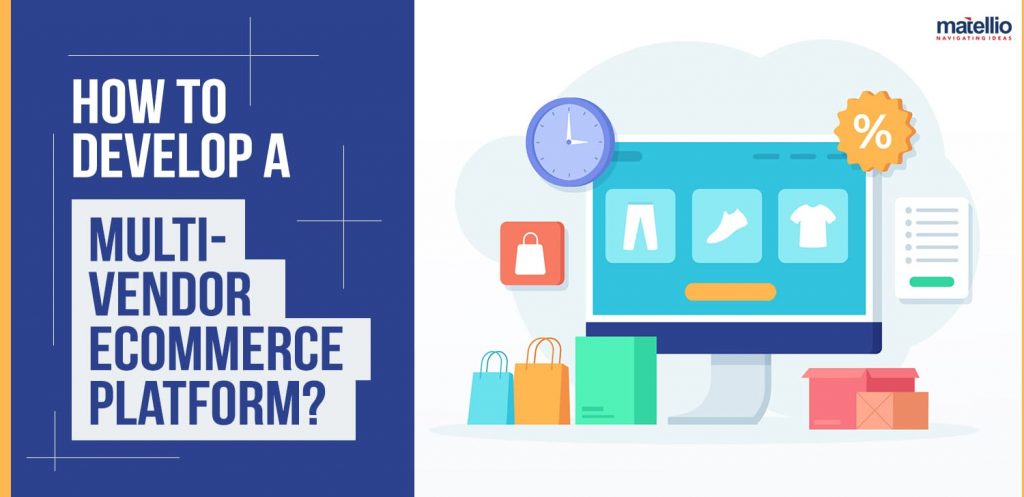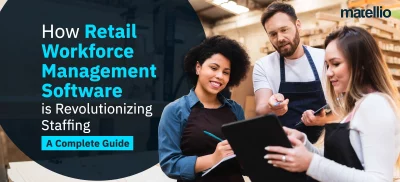
eCommerce has taken the retail industry by storm and has grown vividly for most categories over the past few years. Many sellers and retailers are now either targeting a multivendor eCommerce platform or building their own eCommerce portal to enhance their online presence. And rightly so, as we have seen in the past two years how COVID affected offline stores, and the majority of sales were accomplished online.
We are not implying offline stores have become obsolete, but the rather massive audience online platforms can generate is incomparable to offline stores. If you have been planning to develop a multivendor eCommerce platform, you are at the right place. We will be moving ahead with what an online multivendor platform is and the steps to create one.
What is a Multivendor eCommerce Platform?
This can be best explained with examples like Amazon, eBay, Etsy, etc. Platforms that offer multiple vendors to sell their products can be called multivendor eCommerce platforms. The number one benefit for all parties involved in the competition between multiple vendors. Not only does it allow competitive prices for a customer, but vendors get a better customer base, and the platform owner benefits from both. On the other side of the spectrum, to build multi vendor marketplace you need to take care of typically much more scenarios and use cases than a single-vendor platform.
What is the Difference Between Single and Multivendor eCommerce Platforms?
A single-vendor platform focuses on just one supplier, while a multivendor platform allows multiple sellers for the same product. There are major differences in monetization models as well; while a single-vendor platform is based on sales alone, a multi-vendor platform has various models to choose from.
A multivendor platform owner can generate revenue through cross-selling, advertisements, sales, affiliation, branding, etc.
A Multi-Vendor Ecommerce Platform Includes Panels for 3 Types of Users:
- Admin
- Vendor
- Customer
Each panel would offer user-specific features to take proper advantage of the platform. Let’s discuss in brief the features each should offer.
Admin
- User: Complete control over users and list of their orders classified based on their profile and information.
- Vendor Management: Onboard vendors or remove them and be able to track the complete list of products they have to offer.
- Commissions: Affiliate commissions tracking to ensure a smooth-flowing marketing experience through affiliate channels.
- Centralized Control: Bird’s eye view of the entire website and operations being performed at it; anything and everything on the platform can be controlled.
- Sales: Track entire sales for every customer and vendor and efficiently map it to calculate commissions.
- Website Modification: Make beatifications with the touch of a button, and change the entire user experience without outside help.
- Product Management: Manage and group similar product listings to ensure top quality and descriptions for each and every product listed on your website.
Customers
- Cart: Cart option to add products and group them for checking out in a single transaction.
- Payment Methods: Multiple payment methods integration to ensure seamless payments for every customer.
- Wishlist: Wishlist to save products for later ordering or reviewing; an option can be added to share particular wishlists with friends.
- Order History: View the history for each and every order placed, canceled, or refunded on the eCommerce platform.
- Order Tracking: Integrating logistics within the platform to ensure accurate tracking for every product ordered on the platform.
- Support: Offer support using both chatbots and human support staff to offer 24/7 services to customers.
- Profile: Profile customization for information, size preferences, profile picture, etc., to stand out on the platform.
Vendor
- Listing Upload: Upload the listings of a particular product along with the price and variations offered.
- Product Description: Product descriptions are based on the manufacturer’s information and the seller’s information.
- Loyalty Offers: Different loyalty offers for 2 or more products; you can group packages or offer special discounts to recurring customers.
- Sale and Offers: Reduce prices based on your own dynamics to drive more sales and offer discounts to customers.
- Tracking: Tracking the products on the logistics integrated, you can better keep track of products and how far they have reached, even in case of returns.
- Sales Tracking: Track the sales and download them in a suitable format to keep track of government taxes and total sales.
How to Create a Multivendor Marketplace ?
Step 1: Understanding and Defining the Required Features
Adding and Managing Inventory
Defining and adding categories, listings, items, compatibility, shipping information (according to each vendor), and more. Managing inventory includes all of the above, as well as managing sales and calculation of stock from each available vendor. Inventory management is a major goal of eCommerce app development, and combined with multiple vendors is a difficult feat to achieve. Your platform should include an automated process to take care of everything mentioned above.
Managing Sales and Orders
Managing sales and orders are part of your responsibilities when you create a multivendor eCommerce platform. Specialized applications are created to manage sales, order fulfilments, second chance approaches, cross-selling, and more. For multi-vendor ecommerce development special emphasis should be given to this feature as it will help you be at the top of the competition if done correctly. While all of this may sound tough, when you get the perfect development partner, they will build an automated system with these features included.
Finding and Using Item Data
Specifically for multivendor platforms, there cannot be multiple listings for the same items across the portal. The responsibility for this again falls upon your shoulder. You will need to weed out multiple listings created for the same or similar (for example, a different colored) item and notify the seller the same. Combining listings of each item is a major part of the job and the way a multivendor platform works.
CRM
Customer relationship management is integral for any online portal and more so for an eCommerce portal. You will need to implement review systems, verified reviews for particular sellers, completion rates, and more for every item and every seller on your platform. Feedback and reviews are vital to relationships with customers and communication between customers and sellers. You need to maintain all these aspects to the optimum for your platform to operate smoothly.
Multi-Country Support
Each country has its own set of rules, from languages to privacy and data laws. Before entering a market, you need a detailed study of how things work in a country. Even for your target country (given you are targeting only one), you will need to follow a set of rules to operate as a multi-vendor eCommerce platform. There are various restrictions on the products you could list, and maintaining it would be your responsibility. Multi-language support would be the next step toward operating your platform for a larger audience base.
Order Tracking
Order tracking is something mandatory, while order fulfillment comes as a choice of a multivendor eCommerce platform. Both of these require an immensely robust system to achieve, and you should focus on it as one of the primary requirements when building the list of features. Order tracking enables users to gain more trust in the platform and peace of mind about their delivery timeline. Make sure you add this feature to make the most out of your platform, as most current eCommerce platforms already offer it.
Payment and Refunds
Payments for the customers and transferring them to vendors are part of your job as the platform owner. You will have to take full responsibility for the platform’s security and enable seamless payments and refund tracking. However, refunds can arise due to multiple reasons and need a separate integration under returns, dissatisfaction, and need to merge with order reviews and vendor rating. While it all may sound too complex, a good multi-vendor eCommerce portal development company will assist various interlinking solutions to run your portal at its finest.
Step 2: The Development Part
Whether you opt for a web portal, mobile app, or both depends completely on your requirements. When you are ready to choose and have fixed your budget, you can move on to the development part. There are various aspects of choosing between web portals and mobile apps, and both are based on your budget, requirements, primary customers you plan to target, and so on. A consultant can help you get a grasp of what you actually need, and then you can move forward to the next steps.
The decisions you need to make include the following:
Choosing a Team for Your Multivendor eCommerce Portal Development
Every complicated project calls for a group of skilled developers and designers who know what needs to be done and have the knowledge to implement the asks. You will essentially need team members based on the choices you made above, and additionally, engineers for next-gen technologies (if any) you plan to implement in your portal/apps or either. You can even opt to consult a DevOps consulting company; the numbers would be defined after the consultation said above and preparing a plan for the project’s development.
You will need the following team members:
- Project manager
- Developers
- UI/ UX experts
- QA and testers
- Technology Stack
Your portal needs a robust technology stack to support the functionality of the above-mentioned features. You can either consult with a retail software development company or compare to other platforms whose features you like. Either way, the technology stack choice is variable based on the features you want to perform with absolute accuracy. The choices will be made according to various variables, including the entire stack seen as one.
You can also opt for the DevOps methodology and choose between different project management tools and technologies. You can use JIRA, Amazon EC2, GitHub, Jenkins, Ansible, etc., for if you choose the DevOps approach.
The core development technologies and languages are essential to the overall performance and functioning of your web portal and mobile applications. In case you are planning to integrate AI, it is best to go with AI development services. You can choose a combination of the following for the best results JavaScript, Python, HTML, Java, Postman, React Native, Flutter, Kotlin, Swift, C#, C, MySQL, Oracle Database, Apache, jQuery, PHP, etc.
Also Read: Discover how AI-Powered Product Development is transforming retail innovation with personalized strategies and enhanced customer experiences.
Step 3: Finally, You Need to Figure Out Who to Hire.
Option 1. Setting up your team
This option is recommended for people who already have someone technical on the team or who already have experience building web portals and applications. This is for the fact that ecommerce website development services are complex in itself; with multivendor in the equation, things become much more complicated. If you choose to hire your own team, you will need to spend on building a massive team of experts if you want things to go smoothly.
Option 2. Hire freelance developers
Hiring freelance developers has been the buzzword in the IT industry, but if you plan to outsource your development project to freelancers completely, that might not be a great idea. While hiring freelancers for building specific components can be effective, it should only be combined with an in-house team, given its complex multivendor eCommerce platform.
Option 3. Hire a development company
A staff augmentation company that has expertise in building multivendor eCommerce platforms can be your best bet. It may cost equivalent to or less than setting up your own team, but they could do a much better job if they employed experts to build every component. Professionals would be the best choice given the complexity of the features that need to be implemented, and choosing based on past experience will help you gain desired outcomes.




